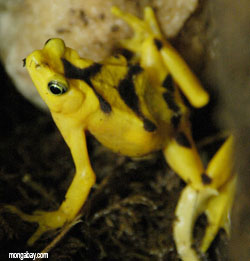The Panamanian golden frog declared extinct by BBC Natural History crew
The Panamanian golden frog declared extinct by BBC Natural History crew
Jeremy Hance, mongabay.com
February 4, 2008
|
|
A national symbol of Panama has been declared extinct by BBC filmmakers. The crew was in Panama to film the unique frog for David Attenborough’s most recent series on reptiles and amphibians, entitled Life in Cold Blood. The filmmakers achieved their objective and captured the golden frog on film, including rarely seen behavior.
The golden frog was devastated by the chytrid fungus, which has caused astounding declines in frog populations worldwide. According to the BBC, soon after the filming, scientists evacuated the remaining frogs from the area. Hilary Jeffkins, senior producer of Life in Cold Blood, is quoted by the BBC as saying, “The whole species is now extinct in Panama – this was one of the last remaining populations. Its final wave was in our programme.”

Panama’s golden frog (Atelopus zetecki). Unlike other frogs, the Panama golden frog lacks eardrums and communicates by waving its hands. In many parts of Panama this frog is considered a good luck charm and people collect it from the wild to put in their homes. This custom further threatens a species already suffering from the killer chytrid fungus (Batrachochytrium dendrobatidis), an infectious skin disease now found in frog populations around the world. |
The ‘waving’ Jeffkins refers to is a rare behavior displayed by the Panamanian golden frog. The frog communicates with others through semaphore, a waving of its foreleg, though it also communicates with sound. Dr. Neil Smith, a researcher with the Smithsonian Tropical Research Institute who believes a few frogs may still exist in the wild, explains the behavior as such, “In the field I have elicited this wave in the absence of other Atelopus. Although described as a ‘wave’ my first impression was that it indicated hesitancy in locomotion. Males often sit out on rocks on fast flowing streams… and they appear to ‘walk’ carefully from rock to rock. Approaching another male under these conditions certainly adds an element of hesitance.” The program also captures the frogs’ mating and wrestling.
A part of Panamanian culture
The Panamanian golden frog appears in local mythology. It is thought that when the frog dies it turns to gold. In general, it is believed that frogs brings good luck to those fortunate enough to see it.
Although it may be extinct in the wild, the yellow and black-spotted frog survives in zoos. Unfortunately it is impossible to know when, if ever, the species will be able to return to the wild.